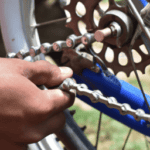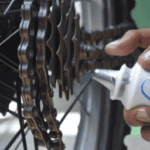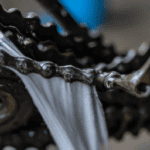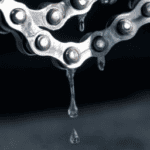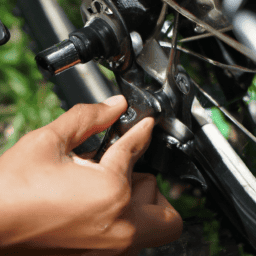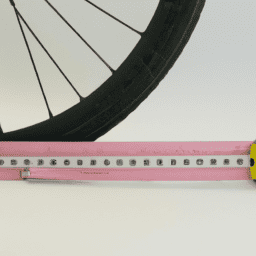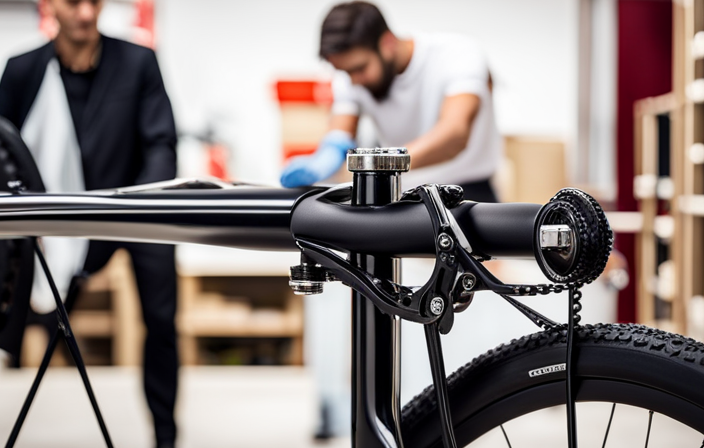Were you aware that by keeping your bicycle chain well-lubricated, it could extend its lifespan by up to four times compared to one that’s not diligently maintained? Absolutely! If you overlook the maintenance of your chain, it can cause excessive wear and tear, potentially leading to expensive repairs or the need for replacements.
Luckily, maintaining your bicycle chain is a simple and straightforward process that can be done in just a few minutes.
In this article, I will guide you through the steps on how to lubricate your bicycle chain. With the right tools and techniques, you can keep your chain running smoothly and efficiently, giving you a more enjoyable and safe biking experience.
So, let’s get started!
Key Takeaways
- Regular lubrication is crucial for bike maintenance and prolongs the life of the chain and other components.
- Different types of lubricants and degreasers are available, and selecting the right one depends on personal preference and level of cleaning required.
- Proper cleaning of the chain is important for effective lubrication and can be achieved with a chain cleaning tool, brush, rag, or cloth.
- Neglecting lubrication and cleaning can lead to costly repairs and replacements, and regular maintenance improves shifting and reduces wear and tear on the drivetrain.
Gather the Necessary Supplies
Before you can begin lubricating your bike chain, you’ll need to gather all the necessary supplies. The good news is that the supplies are simple and can be found at any bike shop or online.
You will need a lubricant specifically designed for bicycle chains, a clean cloth or rag, and a chain cleaning tool if you plan to clean the chain before lubricating it. Regular lubrication is an essential part of bike maintenance. It not only prolongs the life of your chain but also improves your bike’s overall performance.
There are different types of lubricants available for bicycle chains, such as dry, wet, and ceramic. Each type has its benefits, so it’s important to choose the one that best suits your needs. Once you have gathered all the necessary supplies, it’s time to move on to cleaning the chain.
Clean the Chain
Now that I’ve got all the necessary supplies, it’s time to clean my bike chain.
The first step is to remove any dirt and debris that may have accumulated on the chain. I’ll use a dry rag or a soft-bristled brush to gently wipe down the chain.
Next, I’ll apply a degreaser to remove any stubborn grime or grease buildup.
Remove Dirt and Debris
To effectively lubricate your bicycle chain, it’s important to regularly remove dirt and debris using a degreaser and brush. Benefits of regular chain maintenance include prolonging the life of your chain and other bike components, improving shifting performance, and reducing wear and tear on your drivetrain. Choosing the right cleaning tools is essential for achieving a clean chain. A chain cleaning tool or a simple brush can both be effective, depending on the level of grime buildup.
To help you choose the right cleaning tool for your bike, refer to the table below. It outlines the pros and cons of each type of cleaning tool, as well as what type of cyclist they may be best suited for. Now that we’ve discussed the importance of removing dirt and debris, let’s move on to the next step: using a degreaser to thoroughly clean the chain before lubricating.
| Cleaning Tool | Pros | Cons | Best for | |||||
|---|---|---|---|---|---|---|---|---|
| Chain cleaning tool | Thoroughly cleans chain | Expensive | Serious cyclists or those with heavily soiled chains | |||||
| Brush | Affordable | May not reach all areas of the chain | Recreational or occasional cyclists | Rag or cloth | Easy to use | May not remove all grime and debris | Quick clean-ups or as a supplement to other tools |
Use a Degreaser
Keeping your bike running smoothly requires regular cleaning, and using a degreaser is an essential step in this process. When it comes to cleaning your bicycle chain, using a degreaser is a crucial part of removing all the dirt, grime, and debris that has accumulated on it over time. Not only does using a degreaser make the cleaning process easier, but it also helps extend the life of your chain.
There are different types of degreasers available for cleaning bicycle chains, but the most commonly used ones are solvent-based and water-based. Solvent-based degreasers work more effectively and quickly, but they are also harsher on the environment and can cause damage to some bike parts. On the other hand, water-based degreasers are more eco-friendly and safe to use, but they may take longer to work and require more effort to remove all the dirt and debris.
Selecting the right type of degreaser for your bike chain depends on your personal preference and the level of cleaning required.
Now that you’ve removed all the dirt and debris from your bike chain using a degreaser, it’s time to apply the lubricant.
Apply the Lubricant
Now that I’ve cleaned my bicycle chain, it’s time to apply the lubricant.
To do this, I first apply drops of lubricant to each link of the chain. I make sure to rotate the pedals as I apply the drops to ensure that the lubricant is evenly distributed.
Apply Drops of Lubricant
First, take your lubricant and carefully apply a few drops onto each link of the chain, making sure to cover the entire chain evenly. This step is crucial in maintaining the longevity of your bike’s chain. Proper lubrication reduces friction and wear, preventing rust and corrosion buildup. Neglecting to lubricate regularly can lead to costly repairs and replacements down the line.
To ensure the best results, it’s important to choose the right type of lubricant for your bike. There are many options available, including wet, dry, and ceramic lubricants. Each type has its own advantages and disadvantages, so it’s important to do your research before making a selection. Once you’ve selected the appropriate lubricant, apply it sparingly to avoid attracting dirt and debris. Remember, a little goes a long way.
After applying the lubricant, the next step is to rotate the pedals to distribute the lubricant evenly throughout the chain. This helps to ensure that all the links are coated and reduces the risk of over-lubricating one area, which can result in a messy and inefficient ride.
Rotate the Pedals
To ensure a smooth and efficient ride, don’t forget to rotate those pedals after applying the drops of lubricant to your bike’s chain. Proper pedal technique is essential for even distribution of the lubricant on the chain.
Start by positioning one foot at the top of the pedal stroke and the other at the bottom. Next, apply downward pressure on the pedal with the foot at the bottom of the stroke while simultaneously pulling up with the other foot. Continue this motion for a few rotations until the lubricant has spread evenly across the entire chain.
It’s important to note that over time, chain wear can occur due to friction and the build-up of dirt and grime. By regularly lubricating your bike’s chain and using proper pedal technique, you can help prolong its lifespan and prevent unnecessary wear.
Once you’ve finished applying the lubricant and rotating the pedals, it’s time to wipe off any excess lubricant with a clean, dry cloth. This ensures that the chain won’t attract dirt and debris, which can cause further wear and tear.
Wipe off Excess Lubricant
After applying lubricant to your bicycle chain, make sure to wipe off any excess with a clean rag to avoid attracting dirt like a magnet. Wiping off the excess lubricant has numerous benefits. Firstly, it prevents the accumulation of dirt, dust and grime that can get stuck in the excess lubricant and clog up the chain.
Secondly, it ensures that the lubricant is applied where it’s needed the most, rather than being spread haphazardly across the chain. It’s important to note that the frequency of wiping off excess lubricant depends on the riding conditions. If you’re riding in dry and dusty conditions, you may need to wipe off the excess lubricant more frequently.
On the other hand, if you’re riding in wet and muddy conditions, wiping off excess lubricant may not be necessary as it could actually help protect the chain from rust and corrosion. With the excess lubricant wiped off, you can then move on to testing your chain to ensure it’s working smoothly.
Test Your Chain
Now it’s time for you to check the smoothness of your ride by testing your chain. Simply pedal the bike and feel for any resistance or roughness in the motion of the pedals. If you notice any issues, it may indicate that your chain is worn or stretched and needs attention.
Chain wear is a common issue with bicycles, and if left unchecked, it can cause significant damage to the bike and hinder your ride experience. To check for chain wear, use a chain checker tool to measure the stretch of your chain. If the stretch is beyond the recommended limit, it’s time to replace the chain.
By regularly testing and maintaining your chain, you can ensure a smooth and efficient ride that will last longer.
Frequently Asked Questions
How often should I lubricate my bicycle chain?
I typically lubricate my bicycle chain every 100-150 miles for optimal performance. However, this frequency may vary depending on weather conditions. Wet and muddy conditions can increase chain wear, requiring more frequent lubrication.
Can I use any type of lubricant on my bicycle chain?
When choosing a lubricant for your bicycle chain, it’s important to consider compatibility concerns and performance differences. Synthetic lubricants may last longer, but natural lubricants are more environmentally friendly. Consider the pros and cons before making your choice.
Should I lubricate my chain before or after a ride?
Before a ride, lubricating my bicycle chain reduces friction and wear, prolonging its lifespan. However, there are pros and cons to this approach as excess lubrication can attract dirt and debris, ultimately damaging the chain.
Can I use a degreaser to clean my chain instead of soapy water?
Using a degreaser for chain cleaning can be effective, but has pros and cons. It removes grime and buildup, but can also strip lubrication. A chain cleaning tool can enhance effectiveness and reduce mess.
How do I know if my chain is too worn and needs to be replaced?
To determine if my chain needs replacing, I use chain wear indicators or measure chain stretch with a ruler. If it exceeds 0.5%, it’s time to replace it. I’ll need chain pliers and a new chain.
Conclusion
In conclusion, lubricating your bicycle chain is a crucial maintenance task that shouldn’t be neglected. It not only prolongs the life of your chain but also ensures a smooth and efficient ride.
As a cyclist, I’ve learned the importance of regular chain lubrication through experience and trial-and-error. Remember, prevention is better than cure, so take the time to maintain your bike and avoid costly repairs in the long run.
As the saying goes, "a stitch in time saves nine."This applies perfectly to bicycle maintenance, where a little effort and time invested in regular upkeep can save you from major headaches down the road.
With the right tools and techniques, lubricating your bicycle chain is a simple task that can be done in just a few minutes. So, don’t wait until your chain starts making noise or feels stiff – make it a habit to lubricate your chain regularly, and enjoy a smooth and worry-free ride.


